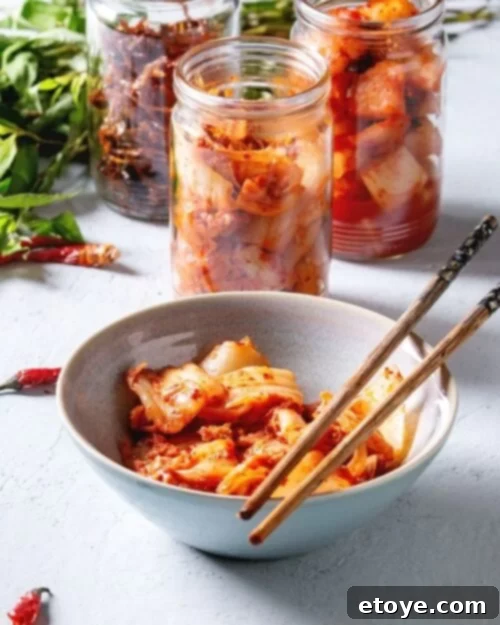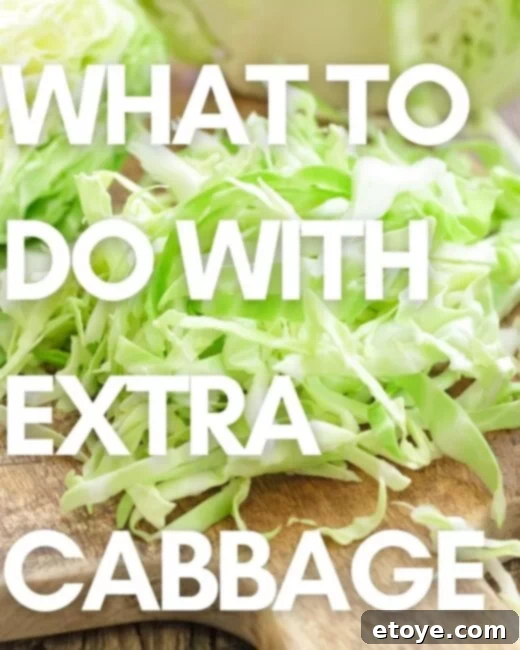Every household, regardless of its unique culinary traditions or family favorites, shares a common challenge: dealing with the abundance of food left over after a hearty meal. The thought of letting perfectly good food go to waste is something we deeply dislike. That’s why we’ve embarked on a mission to transform and repurpose every last bit of your post-meal remnants. Among the most common ingredients I often find myself tucking into the refrigerator after a generous cooking session is cabbage – a versatile, often overlooked vegetable that truly deserves a second act.

Transforming Leftovers: Our Commitment to Zero Food Waste
At the heart of our culinary philosophy is a powerful commitment: to virtually eliminate food waste in every home. We firmly believe that every ingredient has potential beyond its initial preparation. While we’ve shared countless innovative ideas for transforming leftover proteins and side dishes, the humble cabbage often presents a unique opportunity for creative repurposing. This vibrant, nutritious vegetable, frequently bought whole for a single dish, often leaves behind a substantial amount. Our goal is to empower you with exciting, easy-to-follow recipes that breathe new life into your extra cabbage, ensuring nothing gets discarded.

Embracing the “Love Your Leftovers” Philosophy
There are few things more disheartening than seeing good food wasted. It’s a global issue with significant environmental and economic implications, and it’s one we can tackle right from our own kitchens. Our “Love Your Leftovers” series is dedicated to providing imaginative solutions for every kind of leftover. By creatively repurposing these ingredients, not only do we prevent waste, but we also discover exciting new flavors and dishes, making our culinary journey more sustainable and satisfying. The United States alone wastes an astronomical amount of food annually, but with a little creativity and a few smart recipes, we can all contribute to a significant positive change, starting with your abundant supply of extra cabbage.
Why Cabbage is the Ultimate Leftover Hero
Cabbage is an incredibly versatile, nutrient-dense, and affordable vegetable. It’s packed with vitamins K and C, fiber, and antioxidants, making it a healthy addition to any meal. Its robust texture allows it to hold up well in the fridge, giving you ample time to decide on its next culinary adventure. From crunchy salads to tender cooked dishes, cabbage adapts beautifully to a wide array of flavors and cooking methods. However, its large size often means that after preparing a dish like coleslaw, a stir-fry, or a holiday side, you’re left with a significant portion of a head of cabbage. Instead of letting it languish, consider the innovative and delicious possibilities that await your extra cabbage.
Delicious and Creative Extra Cabbage Recipe Ideas
Roll up some Cabbage Rolls with Leftover Cabbage!
#1: Roll Up Some Flavorful Cabbage Rolls Using Extra Cabbage
One of the most satisfying ways to utilize multiple types of leftovers is by transforming them into hearty, comforting cabbage rolls. This “Love Your Leftovers” recipe is a true hero for minimizing food waste, offering a fantastic opportunity to combine various components from previous meals. Both Savoy and green cabbage varieties work wonderfully here, providing that perfect tender wrapper for a myriad of fillings. The process is straightforward: gently steam the cabbage leaves until pliable, carefully cut out the thickest part of the core to create a flat surface for rolling, and then fill them with your chosen mixture.
The beauty of cabbage rolls lies in their adaptability. Whatever protein graced your holiday table or last night’s dinner – be it roasted turkey, succulent beef, or savory pork – can be finely chopped or shredded and incorporated into the filling. Combine your leftover meat with cooked rice, a binding egg, and a medley of seasonings to create a rich, flavorful stuffing. We particularly adore using up leftover brisket in this manner, as its tenderness perfectly complements the cabbage. Don’t be afraid to experiment with different flavor profiles and ingredients. Whether you prefer a classic tomato-based sauce or a lighter, herb-infused broth, cabbage rolls are a delightful way to extend the life of your leftovers. Try some of these delicious combinations, and let us know your favorite!
- Hearty Turkey Cabbage Rolls
- Classic Beef and Rice Cabbage Rolls
- Savory Mushroom Stuffed Cabbage Rolls (Vegetarian Option)
- Spicy Asian Pork Cabbage Rolls
- Delicate Shrimp Stuffed Cabbage Rolls
Leftover Cabbage Gratin
#2: Bake a Cozy Cabbage Gratin Using Extra Cabbage
When the colder months arrive, there’s nothing quite as comforting and satisfying as a warm, bubbly gratin. The irresistible combination of a creamy, rich sauce, tender ingredients, and a golden, often cheesy, topping makes it the quintessential comfort food. While often associated with potatoes, gratin is incredibly versatile and provides an excellent canvas for transforming leftover vegetables, especially cabbage. To create a lighter yet equally delicious version, I frequently incorporate a variety of vegetables. Whether you have leftover green beans, roasted Brussels sprouts, or simply a generous amount of extra cabbage, any of these can be combined or featured solo to create a gratin that will undoubtedly steal the spotlight from other leftovers.
To achieve the perfect texture for your cabbage gratin, a crucial step is to roast the cabbage beforehand, prior to baking it with the luscious cream sauce. This simple technique helps to soften the cabbage, concentrate its flavors, and prevent it from becoming watery in the final dish. Depending on what other vegetables you’re including, such as potatoes or squash, you might need to roast those ahead of time as well. However, vegetables like green beans and Brussels sprouts can often be added directly to the gratin without pre-roasting. A gratin can be served as a sophisticated side dish or even as a satisfying main course, especially when enriched with cheese. For an extra layer of texture and flavor, don’t forget to top your gratin with crushed leftover crackers from your charcuterie board, or even some breadcrumbs for a delightful crunch. Explore these gratin recipes for inspiration:
- Classic Potatoes Au Gratin
- Cheesy Cabbage Gratin
- Creamy Cabbage and Bacon Gratin
- Hearty Green Bean Gratin
- Wholesome Cauliflower Gratin

Leftover Cabbage Kimchi
#3: Make Zesty Kimchi Using Extra Cabbage
If you find yourself with an abundance of leftover cabbage and want a proactive, long-term solution that’s both delicious and healthy, look no further than making kimchi! This vibrant, fermented Korean staple is not only incredibly flavorful but also packed with probiotics, making it a fantastic addition to your diet. Kimchi is one of our absolute favorite toppings for a variety of dishes, including nutritious Buddha Bowls, crispy tacos, and savory fried rice. The best part? Making kimchi at home is surprisingly simple, especially when you have extra cabbage on hand.
We’ve found incredible success with this fantastic recipe shared by Amy Kim of Kimchi Mom. While her recipe specifically calls for green cabbage, Savoy cabbage is also a popular and delicious alternative, often used interchangeably. The beauty of kimchi is that you can adapt the recipe to almost any type of cabbage you have leftover after the holidays or a big cooking project. The fermentation process not only preserves the cabbage but also develops complex, tangy, and spicy flavors that are truly irresistible. Once you’ve successfully made your batch of homemade kimchi, the culinary possibilities are endless.
Our favorite ways to enjoy kimchi often involve incorporating it into Buddha Bowls, which provide another excellent opportunity to use other leftovers like leftover turkey or brisket. You can also mix it into scrambled eggs, serve it alongside grilled meats, or simply enjoy it as a refreshing side dish. We’re excited to see the creative ways you choose to incorporate your homemade kimchi into your meals, or perhaps, like us, you’ll find yourself simply digging into it with a spoon! Either way, you’ll be giving new and exciting life to your extra cabbage. Here are some of our go-to kimchi recipes to inspire you:
- Classic Green Cabbage Kimchi
- Traditional Napa Cabbage Kimchi
- Easy & Fast Mak Kimchi Recipe
- Simple Vegan Kimchi Recipe
- Unique Baby Bok Choy Kimchi
More Creative Ways to Utilize Your Leftover Cabbage
Beyond the fantastic options of cabbage rolls, gratins, and kimchi, your extra cabbage can be transformed into an array of other delightful dishes. Its crisp texture and mild flavor make it incredibly versatile. Consider a vibrant coleslaw, either creamy or vinegar-based, perfect for barbecues or as a fresh side. A quick sauté with garlic and a touch of butter turns humble cabbage into a surprisingly elegant and flavorful side dish that pairs well with almost any main course. For a more substantial meal, cabbage can be a star ingredient in soups and stews, adding bulk and nutrients. Think about a classic beef and cabbage soup or a hearty vegetarian cabbage stew. These dishes are not only comforting but also incredibly effective at using up larger quantities of the vegetable.
Transforming Cabbage into Sauerkraut: Another Fermentation Marvel
Similar to kimchi, sauerkraut is another excellent way to preserve and transform leftover cabbage through fermentation. This German classic, made simply with shredded cabbage and salt, offers a tangy, pungent flavor that complements sausages, reuben sandwiches, and a variety of other dishes. The process is straightforward, requiring minimal ingredients and equipment, and results in a probiotic-rich condiment that can last for months. Making your own sauerkraut is a rewarding experience and a highly efficient method to ensure no part of your extra cabbage ever goes to waste, adding another dimension to your “Love Your Leftovers” repertoire.
Tips for Storing Cabbage and Maximizing Its Shelf Life
To get the most out of your cabbage and give yourself ample time for creative cooking, proper storage is key. A whole head of cabbage can last for several weeks if stored correctly in the refrigerator. Keep it unwashed and unwrapped in the crisper drawer, where the cool, moist environment helps maintain its freshness. Once cut, wrap the unused portion tightly in plastic wrap or place it in an airtight container to prevent dehydration and absorb odors. While cut cabbage will last a shorter period, usually about 3-5 days, these storage methods will help you maximize its life until you’re ready to turn it into another delicious meal, supporting your efforts to reduce food waste.
Embrace the Potential of Every Leaf: Your Journey to Zero Waste Cooking
The journey to a zero-waste kitchen is both rewarding and delicious. By embracing the full potential of ingredients like leftover cabbage, we not only save money and reduce our environmental footprint but also discover new culinary favorites. Cabbage, with its incredible versatility, health benefits, and affordability, truly shines as a hero in the fight against food waste. Whether you choose to roll it into comforting parcels, bake it into a cheesy gratin, ferment it into zesty kimchi or sauerkraut, or simply sauté it for a quick side, you’re making a conscious choice to value every ingredient.
We encourage you to experiment with these ideas and make them your own. Don’t let that extra head of cabbage sit idly in your fridge; give it a vibrant new life and savor the satisfaction of sustainable cooking. Share your creations with us and join the movement to transform leftovers into legendary meals. Happy cooking, and remember: every leaf counts!
